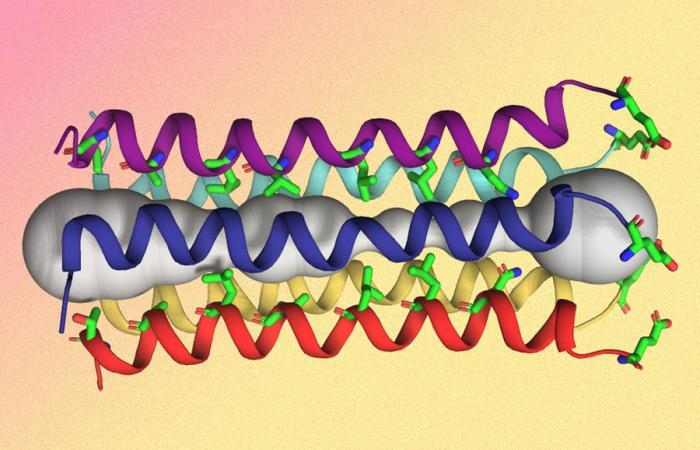If researchers could find ways to block this channel, they could potentially reduce the pathogenicity of the virus and disrupt virus replication, says Mei Hong, MIT professor of chemistry. In this study, the researchers looked at the binding sites of two drugs that block the channel. However, these active ingredients bind only weakly, so that they are not effective inhibitors of the E protein.
“Our results could be useful for medicinal chemists to develop alternative small molecules that target this channel with high affinity,” says Hong, the lead author of the new study.
MIT graduate student Venkata Mandala is the lead author of the paper, which appears in Nature Structural and Molecular Biology. Other authors include MIT postdoc Matthew McKay, MIT alumni Alexander Shcherbakov and Aurelio Dregni, and Antonios Kolocouris, Professor of Pharmaceutical Chemistry at the University of Athens.
Structural challenges
Hong’s laboratory specializes in studying the structures of proteins embedded in cell membranes, which are often difficult to analyze due to the disruption of the lipid membrane. With the help of nuclear magnetic resonance spectroscopy (NMR), she had previously developed various techniques with which she can obtain precise structural information on the atomic level about these proteins embedded in the membrane.
When the SARS-CoV-2 outbreak began earlier this year, Hong and her students decided to focus their efforts on one of the novel coronavirus proteins. She limited herself to the E protein in part because it resembles an influenza protein called the M2 proton channel that she previously studied. Both viral proteins consist of bundles of several helical proteins.
“We determined the Influenza B M2 structure after about 1.5 years of hard work. We learned how to clone, express and purify a virus membrane protein from scratch and which experimental NMR strategies have to be used to solve the structure of a homo-oligomer bundle, ”says Hong. “This experience turned out to be the perfect training ground for studying SARS-CoV-2 E.”
The researchers were able to clone and purify the E protein in two and a half months. To determine its structure, the researchers embedded it in a lipid bilayer, similar to a cell membrane, and then analyzed it using NMR, which uses the magnetic properties of atomic nuclei to reveal the structures of the molecules that contain these nuclei. They measured the NMR spectra for two months without interruption with the high-field NMR instrument at MIT, a 900-megahertz spectrometer, and with 800- and 600-megahertz spectrometers.
Hong and her colleagues found that the part of the E protein that is embedded in the lipid bilayer, known as the transmembrane domain, is composed of a bundle of five helices. The helices remain largely immobile within this bundle, creating a narrow channel that is much narrower than the influenza M2 channel.
The researchers also identified several amino acids at one end of the channel that can pull positively charged ions like calcium into the channel. They believe that the structure they report on in this article is the closed state of the channel, and they now hope to determine the structure of the open state, which should shed light on how the channel is opened and closed.
Basic research
The researchers also found that two drugs – amantadine, used to treat influenza and hexamethylene amiloride, used to treat high blood pressure – can block the entrance of the E-channel. However, these drugs bind only weakly to the E protein. If stronger inhibitors could be developed, they could be potential drug candidates for treating Covid-19, says Hong.
The study shows that basic scientific research can make important contributions to solving medical problems, she adds.
“Even after the pandemic is over, it is important for our society to recognize and remember that basic scientific research into viral proteins or bacterial proteins must be vigorously pursued in order for us to prevent pandemics,” says Hong. “The human costs and the economic costs are just too high.”
The research was funded by the National Institutes of Health and the MIT School of Science Sloan Fund.
These were the details of the news Chemists discover the structure of an important coronavirus protein for this day. We hope that we have succeeded by giving you the full details and information. To follow all our news, you can subscribe to the alerts system or to one of our different systems to provide you with all that is new.
It is also worth noting that the original news has been published and is available at de24.news and the editorial team at AlKhaleej Today has confirmed it and it has been modified, and it may have been completely transferred or quoted from it and you can read and follow this news from its main source.

